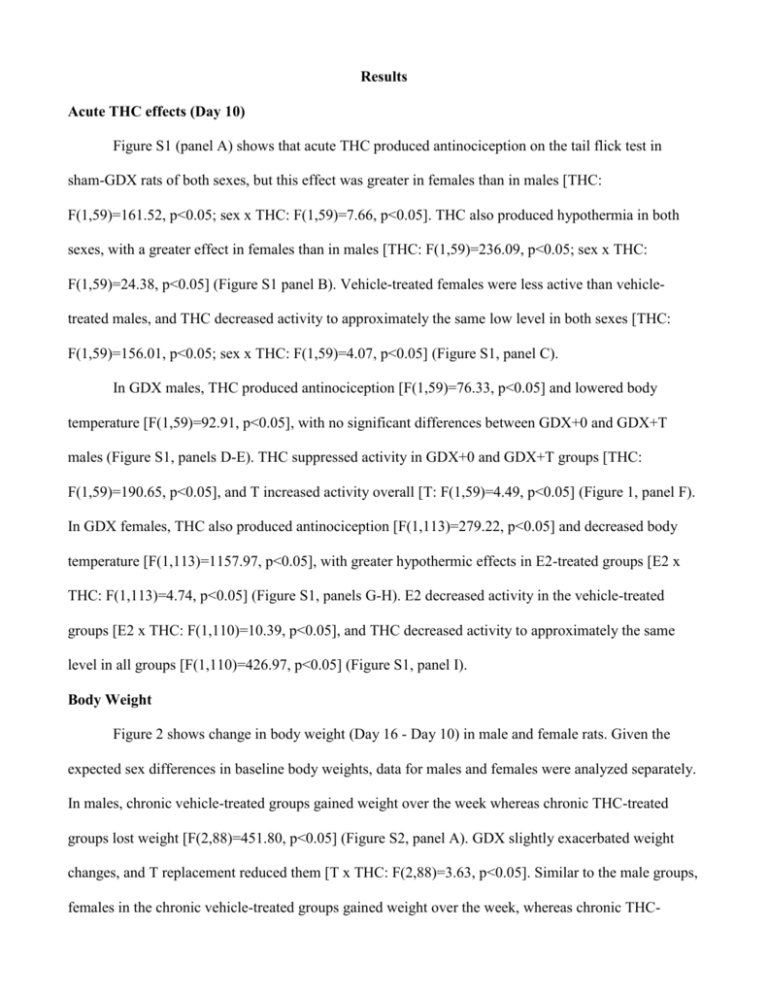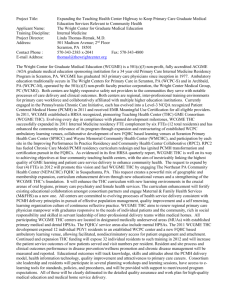
Results
Acute THC effects (Day 10)
Figure S1 (panel A) shows that acute THC produced antinociception on the tail flick test in
sham-GDX rats of both sexes, but this effect was greater in females than in males [THC:
F(1,59)=161.52, p<0.05; sex x THC: F(1,59)=7.66, p<0.05]. THC also produced hypothermia in both
sexes, with a greater effect in females than in males [THC: F(1,59)=236.09, p<0.05; sex x THC:
F(1,59)=24.38, p<0.05] (Figure S1 panel B). Vehicle-treated females were less active than vehicletreated males, and THC decreased activity to approximately the same low level in both sexes [THC:
F(1,59)=156.01, p<0.05; sex x THC: F(1,59)=4.07, p<0.05] (Figure S1, panel C).
In GDX males, THC produced antinociception [F(1,59)=76.33, p<0.05] and lowered body
temperature [F(1,59)=92.91, p<0.05], with no significant differences between GDX+0 and GDX+T
males (Figure S1, panels D-E). THC suppressed activity in GDX+0 and GDX+T groups [THC:
F(1,59)=190.65, p<0.05], and T increased activity overall [T: F(1,59)=4.49, p<0.05] (Figure 1, panel F).
In GDX females, THC also produced antinociception [F(1,113)=279.22, p<0.05] and decreased body
temperature [F(1,113)=1157.97, p<0.05], with greater hypothermic effects in E2-treated groups [E2 x
THC: F(1,113)=4.74, p<0.05] (Figure S1, panels G-H). E2 decreased activity in the vehicle-treated
groups [E2 x THC: F(1,110)=10.39, p<0.05], and THC decreased activity to approximately the same
level in all groups [F(1,110)=426.97, p<0.05] (Figure S1, panel I).
Body Weight
Figure 2 shows change in body weight (Day 16 - Day 10) in male and female rats. Given the
expected sex differences in baseline body weights, data for males and females were analyzed separately.
In males, chronic vehicle-treated groups gained weight over the week whereas chronic THC-treated
groups lost weight [F(2,88)=451.80, p<0.05] (Figure S2, panel A). GDX slightly exacerbated weight
changes, and T replacement reduced them [T x THC: F(2,88)=3.63, p<0.05]. Similar to the male groups,
females in the chronic vehicle-treated groups gained weight over the week, whereas chronic THC-
treated females lost weight [F(1,143)=589.42, p<0.05] (Figure S2, panel B). These body weight changes
were exacerbated in GDX females that did not receive E2 (GDX+0, GDX+P4), and E2 replacement
normalized body weight changes in both chronic vehicle- and chronic THC-treated females [hormone x
THC: F(4,143)=40.18, p<0.05]. P4 had no effect on change in body weight.
Discussion of Acute Effects of THC and Effects of THC on Body Weight
Previous research has shown that acute THC produces characteristic locomotor suppression,
antinociception, and hypothermia in rodents of both sexes (Martin et al., 1991; Wiley et al., 2007). In the
present study, results in sham-GDX rats replicate these findings and extend them to GDX males and
females with and without hormone replacement. Sex differences in the magnitude of effects were also
evident. In accord with past studies, acute THC produced greater antinociception and hypothermia in
intact (sham-GDX) females than males (Craft et al., 2012; Tseng and Craft, 2001; Wakley et al., 2014b;
Wiley et al., 2007). Similarly, E2 increased THC-induced hypothermia for GDX females; however, the
present study did not mirror the sex differences in or T modulation of locomotor suppression, or E2
modulation of antinociception found in past studies (Craft and Leitl, 2008; Marusich et al., 2014). The
sex differences in baseline locomotor activity for sham-GDX rats compared to previous studies may be
due to procedural differences. The present study used a 15 min locomotor session, which showed lower
baseline activity for sham-GDX females. In contrast, previous studies have used 5 min (Marusich et al.,
2014) or 10 min (Wiley et al., 2007) sessions, and found similar levels of baseline activity for intact
males and females. When data from the present study were examined in 5 min bins, sham-GDX males
and females showed similar activity levels during the first 5 min bin. This suggests that females develop
greater habituation to the locomotor activity apparatus than males, which is only evident when a longer
session is used.
Similar to previous research, chronic THC administration caused weight loss in males and
females (Marusich et al., 2014), presumably through decreased food consumption (Wiley et al., 2005)
although food consumption was not explicitly measured here. T and E2 aided in preserving normal body
weight under non-homeostatic conditions (e.g., during chronic drug administration) in GDX males and
GDX females, respectively.
References
Craft, R.M., & Leitl, M.D. (2008). Gonadal hormone modulation of the behavioral effects of delta9tetrahydrocannabinol in male and female rats. European Journal of Pharmacology, 578, 37–42.
Craft, R.M., Wakley, A.A., Tsutsui, K.T., & Laggart, J.D. (2012). Sex differences in cannabinoid 1 vs.
cannabinoid 2 receptor-selective antagonism of antinociception produced by delta9tetrahydrocannabinol and CP55,940 in the rat. Journal of Pharmacology and Experimental
Therapeutics, 340, 787–800.
Martin, B.R., Compton, D.R., Thomas, B.F., Prescott, W.R., Little, P.J., & Razdan, R.K., et al. (1991).
Behavioral, biochemical, and molecular modeling evaluations of cannabinoid analogs.
Pharmacology, Biochemistry, and Behavior, 40, 471–478.
Marusich, J.A., Lefever, T.W., Antonazzo, K.R., Craft, R.M., & Wiley, J.L. (2014). Evaluation of sex
differences in cannabinoid dependence. Drug and Alcohol Dependence, 137, 20–28.
Tseng, A.H., & Craft, R.M. (2001). Sex differences in antinociceptive and motoric effects of
cannabinoids. European Journal of Pharmacology, 430, 41–47.
Wakley, A.A., Wiley, J.L., & Craft, R.M. (2014b). Sex differences in antinociceptive tolerance to delta9-tetrahydrocannabinol in the rat. Drug and Alcohol Dependence, 143,22-28.
Wiley, J.L., O'Connell, M.M., Tokarz, M.E., & Wright, M.J., Jr. (2007). Pharmacological effects of
acute and repeated administration of delta9-tetrahydrocannabinol in adolescent and adult rats.
Journal of Pharmacology and Experimental Therapeutics, 320, 1097-1105.
Figure S1. Acute effects of THC on tail flick antinociception (left column), change in body temperature
(center column), and locomotor activity (right column). Mean (±SEM) values are shown for sham-GDX
males and females (n=7-8/group; panels A-B), GDX males (n=7-8/group; panels C-D), and GDX
females (n=6-8/group; panels E-F). * significant sex difference (in sham-GDX rats), T effect (GDX
males), or E2 effect (in GDX females) (main effect). # significant difference from Veh group (main
effect). % significant difference from male (sham-GDX) or GDX+0 (GDX females) for the same drug
group (interaction). GDX: gonadectomized; E2: estradiol; MPE: maximum possible effect; P4:
progesterone; T: testosterone: THC: Δ9-tetrahydrocannabinol; Veh: vehicle.
Figure S2. Effect of chronic THC treatment on body weight, as change in body weight from Day 10 to
Day 16. Mean (±SEM) values are shown for males (n=7-8/group; panel A) and females (n=6-8/group;
panel B). * significant T effect (in males), or E2 effect (in females) (main effect). # significant
difference from Veh group (main effect). GDX: gonadectomized; E2: estradiol; P4: progesterone; T;
testosterone; THC: Δ9-tetrahydrocannabinol; Veh: vehicle.










